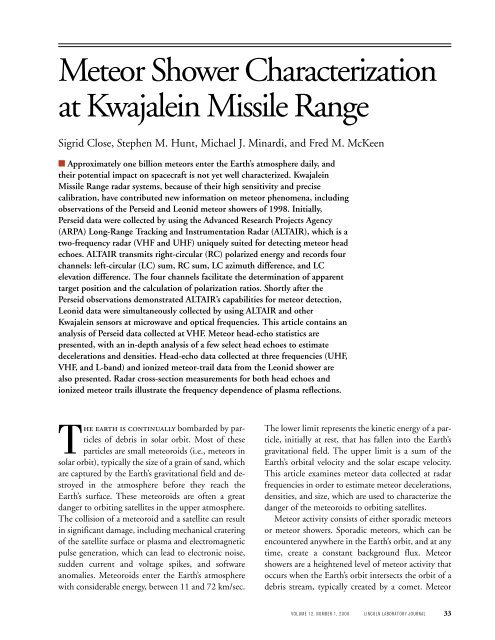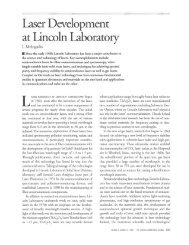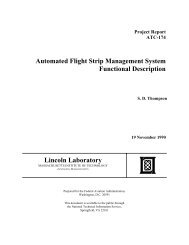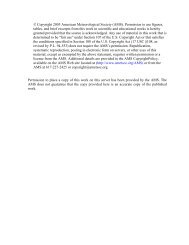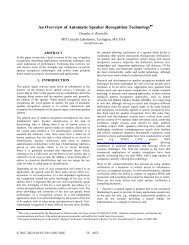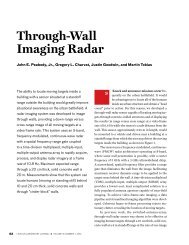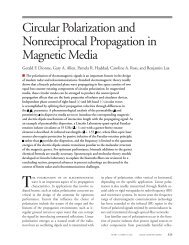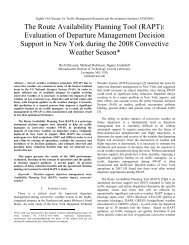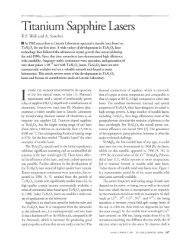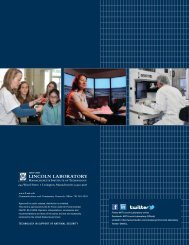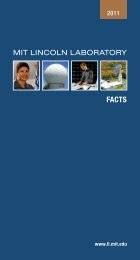Meteor Shower Characterization at Kwajalein Missile Range
Meteor Shower Characterization at Kwajalein Missile Range
Meteor Shower Characterization at Kwajalein Missile Range
You also want an ePaper? Increase the reach of your titles
YUMPU automatically turns print PDFs into web optimized ePapers that Google loves.
• CLOSE, HUNT, MINARDI, AND MCKEEN<br />
<strong>Meteor</strong> <strong>Shower</strong> <strong>Characteriz<strong>at</strong>ion</strong> <strong>at</strong> <strong>Kwajalein</strong> <strong>Missile</strong> <strong>Range</strong><br />
<strong>Meteor</strong> <strong>Shower</strong> <strong>Characteriz<strong>at</strong>ion</strong><br />
<strong>at</strong> <strong>Kwajalein</strong> <strong>Missile</strong> <strong>Range</strong><br />
Sigrid Close, Stephen M. Hunt, Michael J. Minardi, and Fred M. McKeen<br />
■ Approxim<strong>at</strong>ely one billion meteors enter the Earth’s <strong>at</strong>mosphere daily, and<br />
their potential impact on spacecraft is not yet well characterized. <strong>Kwajalein</strong><br />
<strong>Missile</strong> <strong>Range</strong> radar systems, because of their high sensitivity and precise<br />
calibr<strong>at</strong>ion, have contributed new inform<strong>at</strong>ion on meteor phenomena, including<br />
observ<strong>at</strong>ions of the Perseid and Leonid meteor showers of 1998. Initially,<br />
Perseid d<strong>at</strong>a were collected by using the Advanced Research Projects Agency<br />
(ARPA) Long-<strong>Range</strong> Tracking and Instrument<strong>at</strong>ion Radar (ALTAIR), which is a<br />
two-frequency radar (VHF and UHF) uniquely suited for detecting meteor head<br />
echoes. ALTAIR transmits right-circular (RC) polarized energy and records four<br />
channels: left-circular (LC) sum, RC sum, LC azimuth difference, and LC<br />
elev<strong>at</strong>ion difference. The four channels facilit<strong>at</strong>e the determin<strong>at</strong>ion of apparent<br />
target position and the calcul<strong>at</strong>ion of polariz<strong>at</strong>ion r<strong>at</strong>ios. Shortly after the<br />
Perseid observ<strong>at</strong>ions demonstr<strong>at</strong>ed ALTAIR’s capabilities for meteor detection,<br />
Leonid d<strong>at</strong>a were simultaneously collected by using ALTAIR and other<br />
<strong>Kwajalein</strong> sensors <strong>at</strong> microwave and optical frequencies. This article contains an<br />
analysis of Perseid d<strong>at</strong>a collected <strong>at</strong> VHF. <strong>Meteor</strong> head-echo st<strong>at</strong>istics are<br />
presented, with an in-depth analysis of a few select head echoes to estim<strong>at</strong>e<br />
deceler<strong>at</strong>ions and densities. Head-echo d<strong>at</strong>a collected <strong>at</strong> three frequencies (UHF,<br />
VHF, and L-band) and ionized meteor-trail d<strong>at</strong>a from the Leonid shower are<br />
also presented. Radar cross-section measurements for both head echoes and<br />
ionized meteor trails illustr<strong>at</strong>e the frequency dependence of plasma reflections.<br />
The earth is continually bombarded by particles<br />
of debris in solar orbit. Most of these<br />
particles are small meteoroids (i.e., meteors in<br />
solar orbit), typically the size of a grain of sand, which<br />
are captured by the Earth’s gravit<strong>at</strong>ional field and destroyed<br />
in the <strong>at</strong>mosphere before they reach the<br />
Earth’s surface. These meteoroids are often a gre<strong>at</strong><br />
danger to orbiting s<strong>at</strong>ellites in the upper <strong>at</strong>mosphere.<br />
The collision of a meteoroid and a s<strong>at</strong>ellite can result<br />
in significant damage, including mechanical cr<strong>at</strong>ering<br />
of the s<strong>at</strong>ellite surface or plasma and electromagnetic<br />
pulse gener<strong>at</strong>ion, which can lead to electronic noise,<br />
sudden current and voltage spikes, and software<br />
anomalies. <strong>Meteor</strong>oids enter the Earth’s <strong>at</strong>mosphere<br />
with considerable energy, between 11 and 72 km/sec.<br />
The lower limit represents the kinetic energy of a particle,<br />
initially <strong>at</strong> rest, th<strong>at</strong> has fallen into the Earth’s<br />
gravit<strong>at</strong>ional field. The upper limit is a sum of the<br />
Earth’s orbital velocity and the solar escape velocity.<br />
This article examines meteor d<strong>at</strong>a collected <strong>at</strong> radar<br />
frequencies in order to estim<strong>at</strong>e meteor deceler<strong>at</strong>ions,<br />
densities, and size, which are used to characterize the<br />
danger of the meteoroids to orbiting s<strong>at</strong>ellites.<br />
<strong>Meteor</strong> activity consists of either sporadic meteors<br />
or meteor showers. Sporadic meteors, which can be<br />
encountered anywhere in the Earth’s orbit, and <strong>at</strong> any<br />
time, cre<strong>at</strong>e a constant background flux. <strong>Meteor</strong><br />
showers are a heightened level of meteor activity th<strong>at</strong><br />
occurs when the Earth’s orbit intersects the orbit of a<br />
debris stream, typically cre<strong>at</strong>ed by a comet. <strong>Meteor</strong><br />
VOLUME 12, NUMBER 1, 2000 LINCOLN LABORATORY JOURNAL 33
showers occur <strong>at</strong> the same time every year, and the<br />
meteors appear to an observer to be radi<strong>at</strong>ing from a<br />
single point called the radiant. This effect occurs because<br />
all the meteors, origin<strong>at</strong>ing from a single object,<br />
are traveling on roughly parallel p<strong>at</strong>hs. <strong>Meteor</strong> showers<br />
take their name from the star constell<strong>at</strong>ion th<strong>at</strong><br />
contains the radiant point; for example, the Leonid<br />
shower takes its name from the constell<strong>at</strong>ion Leo.<br />
When meteoroids enter the Earth’s <strong>at</strong>mosphere,<br />
they collide with and ionize (i.e., produce a transfer of<br />
energy th<strong>at</strong> frees an electron) neutral air molecules<br />
and <strong>at</strong>oms, which gener<strong>at</strong>es localized plasma regions.<br />
Ioniz<strong>at</strong>ion takes place in the E region of the ionosphere<br />
(between approxim<strong>at</strong>ely 80 to 140 km in altitude).<br />
Above 140 km the neutral particle density<br />
tends to be too low to ionize, and below 80 km the<br />
meteor usually has been destroyed. <strong>Meteor</strong> ioniz<strong>at</strong>ion<br />
in the E region is classified into two c<strong>at</strong>egories—the<br />
ionized meteor trail and a localized spherical ionized<br />
region surrounding the meteor [1]. The meteor trail<br />
is cylindrical in shape and typically kilometers in<br />
length and meters in diameter; <strong>at</strong> radar frequencies,<br />
trails are often modeled as a long conducting wire.<br />
Trail dur<strong>at</strong>ion varies but is typically less than one second<br />
(although some trails last for many minutes) [2].<br />
Trails are st<strong>at</strong>ionary except for motion due to <strong>at</strong>mospheric<br />
winds. Specular reflection from these trails<br />
occurs if incident radio waves are perpendicular to the<br />
cylindrical trail, producing strong returns th<strong>at</strong> have<br />
been studied since the 1940s.<br />
The localized spherical ioniz<strong>at</strong>ion surrounding the<br />
meteor produces a much weaker type of reflection<br />
known as the head echo. Head echoes travel with the<br />
same velocity as the meteor, with cross sections th<strong>at</strong><br />
depend on the size and shape of the meteor. Because<br />
the size of the meteor subsequently depends on the<br />
r<strong>at</strong>e of mass dissip<strong>at</strong>ion, which in turn depends on<br />
the air density and meteor velocity, cross sections vary<br />
among meteors and change rapidly as a meteor travels<br />
through the ionosphere. By analyzing head echoes we<br />
can deduce meteor deceler<strong>at</strong>ions and densities, which<br />
are independent of assumptions about ioniz<strong>at</strong>ion.<br />
The current high interest in meteors is due to the<br />
recent Leonid meteor storm in 1998. The annual Leonid<br />
meteor shower, which occurs in November and<br />
was cre<strong>at</strong>ed from the comet Tempel-Tuttle, developed<br />
34 LINCOLN LABORATORY JOURNAL VOLUME 12, NUMBER 1, 2000<br />
• CLOSE, HUNT, MINARDI, AND MCKEEN<br />
<strong>Meteor</strong> <strong>Shower</strong> <strong>Characteriz<strong>at</strong>ion</strong> <strong>at</strong> <strong>Kwajalein</strong> <strong>Missile</strong> <strong>Range</strong><br />
into a meteor storm in 1998 and 1999 and is expected<br />
to develop into equally intense storm-like activity<br />
in 2000. The higher flux of these meteor storms<br />
arises because comet Tempel-Tuttle crossed the orbital<br />
p<strong>at</strong>h of the Earth in February 1998, as illustr<strong>at</strong>ed<br />
in Figure 1, and the gre<strong>at</strong>est density of meteoroids is<br />
colloc<strong>at</strong>ed in the proximity of the comet. In addition,<br />
comet Tempel-Tuttle is inclined only 17° to the<br />
Earth’s orbital plane, which increases the dur<strong>at</strong>ion of<br />
the meteor shower. Finally, the comet’s retrograde orbit<br />
around the sun (opposite the direction of the<br />
Earth’s orbit) increases the brilliance and visible numbers<br />
of the meteor shower because the Earth is colliding<br />
with the meteoroids <strong>at</strong> their maximum velocity.<br />
Comet Tempel-Tuttle has a thirty-three-year orbital<br />
period; thus the last Leonid storm occurred in<br />
1966, when few s<strong>at</strong>ellites were in orbit. At th<strong>at</strong> time, a<br />
peak flux r<strong>at</strong>e of forty meteors per second was detected<br />
by visual observ<strong>at</strong>ions [3]. Because of the increased<br />
risk of a meteor shower to the current s<strong>at</strong>ellite<br />
popul<strong>at</strong>ion of over seven hundred oper<strong>at</strong>ional spacecraft,<br />
a worldwide meteor d<strong>at</strong>a-collection effort was<br />
initi<strong>at</strong>ed to help characterize the Leonid storm and its<br />
potential thre<strong>at</strong> to s<strong>at</strong>ellite safety [4]. The Advanced<br />
Research Projects Agency (ARPA) Long-<strong>Range</strong> Tracking<br />
and Instrument<strong>at</strong>ion Radar (ALTAIR), which was<br />
requested by the U.S. Air Force Office of Scientific<br />
Research to support this effort, collected d<strong>at</strong>a on both<br />
the Perseid shower and the Leonid storm in 1998.<br />
Earth's orbit<br />
Sun<br />
17°<br />
Tempel-Tuttle's<br />
orbit<br />
FIGURE 1. The intersection of the Earth’s orbit with the<br />
comet Tempel-Tuttle in February 1998. This intersection, in<br />
combin<strong>at</strong>ion with Tempel-Tuttle’s retrograde motion and low<br />
orbital inclin<strong>at</strong>ion of 17°, produced an intense meteor storm<br />
in November of 1998 and 1999 and is expected to produce a<br />
similarly intense meteor storm in 2000. These storms are actively<br />
studied by radar researchers for inform<strong>at</strong>ion on meteor<br />
head echoes and meteor trails.
ALTAIR is loc<strong>at</strong>ed in the central Pacific Ocean on<br />
the island of Roi-Namur in the <strong>Kwajalein</strong> Atoll, Republic<br />
of the Marshall Islands, <strong>at</strong> 9° N l<strong>at</strong>itude and<br />
167° E longitude. Shown in Figure 2, ALTAIR has a<br />
mechanically steered, 46-m-diameter dish antenna<br />
th<strong>at</strong> transmits a peak power of 6 MW with a 2.8°<br />
beamwidth <strong>at</strong> VHF and a 1.1° beamwidth <strong>at</strong> UHF.<br />
ALTAIR is part of a system of radars known as the<br />
Kiernan Reentry Measurements Site (KREMS).<br />
KREMS mission areas include the support of missile<br />
testing activities, such as oper<strong>at</strong>ional tests of fielded<br />
ballistic missile systems and developmental testing of<br />
missile defense systems.<br />
ALTAIR has a second and much larger mission<br />
area, providing support to U.S. Space Command for<br />
the space-surveillance mission. ALTAIR dedic<strong>at</strong>es<br />
128 hours per week to providing d<strong>at</strong>a to Space Command<br />
on nearly every aspect of space surveillance.<br />
The remaining forty hours per week are devoted to<br />
system maintenance and development. However, AL-<br />
TAIR is available with a fifteen-minute recall for<br />
high-priority tasks even during these maintenance periods.<br />
Lincoln Labor<strong>at</strong>ory fills the role of scientific<br />
advisor to the U.S. Army <strong>Kwajalein</strong> Atoll, which oper<strong>at</strong>es<br />
the entire radar range. In particular, Lincoln<br />
Labor<strong>at</strong>ory has responsibility for the quality of<br />
ALTAIR’s space-surveillance mission.<br />
ALTAIR’s high peak power and large antenna aperture<br />
combine to cre<strong>at</strong>e high system sensitivity. By using<br />
the most sensitive waveforms available, ALTAIR<br />
can detect a –74-dBsm (decibels rel<strong>at</strong>ive to a square<br />
meter) target <strong>at</strong> VHF and a –80-dBsm target <strong>at</strong> UHF<br />
<strong>at</strong> a range of a hundred kilometers, which is a typical<br />
range for meteor observ<strong>at</strong>ions. This high system sensitivity<br />
makes ALTAIR uniquely suited for the detection<br />
of small head echoes, which so far have been neglected<br />
rel<strong>at</strong>ive to radar research on larger trail echoes.<br />
Because head echoes give direct measurements of meteor<br />
velocities, important meteor parameters such as<br />
size and density can be inferred.<br />
Perseid <strong>Meteor</strong> Observ<strong>at</strong>ions<br />
The first meteor d<strong>at</strong>a collection discussed in this article<br />
occurred during the Perseid meteor shower. The<br />
purpose of the d<strong>at</strong>a collection was to determine the<br />
suitability of ALTAIR for meteor observ<strong>at</strong>ion. D<strong>at</strong>a<br />
• CLOSE, HUNT, MINARDI, AND MCKEEN<br />
<strong>Meteor</strong> <strong>Shower</strong> <strong>Characteriz<strong>at</strong>ion</strong> <strong>at</strong> <strong>Kwajalein</strong> <strong>Missile</strong> <strong>Range</strong><br />
FIGURE 2. The Advanced Research Projects Agency<br />
(ARPA) Long-<strong>Range</strong> Tracking and Instrument<strong>at</strong>ion Radar<br />
(ALTAIR), loc<strong>at</strong>ed on the island of Roi-Namur in the <strong>Kwajalein</strong><br />
Atoll, Republic of the Marshall Islands, in the Pacific<br />
Ocean. ALTAIR has a mechanically steered, 46-m-diameter<br />
dish antenna th<strong>at</strong> transmits a peak power of 6 MW with a<br />
2.8° beamwidth <strong>at</strong> VHF and a 1.1° beamwidth <strong>at</strong> UHF.<br />
ALTAIR’s primary mission area is space surveillance, including<br />
observ<strong>at</strong>ions of meteor activity, but it also contributes<br />
to oper<strong>at</strong>ional testing of fielded ballistic missile systems<br />
and developmental testing of missile defense systems.<br />
were collected <strong>at</strong> two different times during the early<br />
morning hours of 12 August 1998. First, the ALTAIR<br />
antenna was pointed <strong>at</strong> the radiant point in the constell<strong>at</strong>ion<br />
Perseus when it was <strong>at</strong> its maximum elev<strong>at</strong>ion<br />
of 40°. Ten minutes of d<strong>at</strong>a were recorded. While<br />
the radiant point was still <strong>at</strong> its peak elev<strong>at</strong>ion, five<br />
minutes of off-radiant d<strong>at</strong>a were collected after moving<br />
the antenna 30° in azimuth. While the antenna is<br />
pointing <strong>at</strong> the radiant, Perseid meteors follow p<strong>at</strong>hs<br />
roughly aligned with the antenna beam, and they<br />
therefore endure longer in the beam. The purpose of<br />
collecting the off-radiant d<strong>at</strong>a was to observe more of<br />
the sporadic meteor head echoes and to have a gre<strong>at</strong>er<br />
chance of seeing returns from meteor trails.<br />
Amplitude and phase d<strong>at</strong>a were recorded for each<br />
of four receive channels: sum right circular (SRC),<br />
VOLUME 12, NUMBER 1, 2000 LINCOLN LABORATORY JOURNAL 35
Altitude (km)<br />
105<br />
100<br />
95<br />
90<br />
85<br />
Head echoes<br />
80<br />
75<br />
Head echo with<br />
trail form<strong>at</strong>ion<br />
1.5 2.0 2.5 3.0 3.5<br />
Time (sec)<br />
FIGURE 3. <strong>Range</strong>-time-intensity (RTI) image showing three<br />
meteor head echoes and a head echo with an associ<strong>at</strong>ed<br />
trail form<strong>at</strong>ion.<br />
sum left circular (SLC), azimuth-difference left circular<br />
(ALC), and elev<strong>at</strong>ion-difference left circular<br />
(ELC). D<strong>at</strong>a samples were collected every seventyfive<br />
meters for ranges corresponding to altitudes between<br />
70 and 140 km. ALTAIR radi<strong>at</strong>ed a VHF 260-<br />
µsec (V260M) pulse fifty times per second. The pulse<br />
was modul<strong>at</strong>ed with a 1-MHz linear frequency<br />
modul<strong>at</strong>ion, which allowed the pulse to be compressed<br />
to 1 µsec after receive filtering. By using this<br />
waveform, ALTAIR can detect a –72-dBsm target <strong>at</strong> a<br />
range of a hundred kilometers.<br />
Perseid D<strong>at</strong>a Analysis<br />
Figure 3 shows a represent<strong>at</strong>ive range-time-intensity<br />
(RTI) image of 3.5 sec of SLC channel d<strong>at</strong>a. Image<br />
color in the figure corresponds to the received signalto-noise<br />
r<strong>at</strong>io (SNR). This d<strong>at</strong>a sample, which contains<br />
both meteor head echoes and an ionized trail return,<br />
represents the raw d<strong>at</strong>a th<strong>at</strong> we processed to<br />
detect and measure meteor head echoes (note the<br />
range sidelobes resulting from the strong return off<br />
the trail). The amplitude and phase d<strong>at</strong>a were reduced<br />
by using MATLAB scripts. First, receive biases were<br />
estim<strong>at</strong>ed for all four d<strong>at</strong>a channels by averaging the<br />
d<strong>at</strong>a over an 80,000-sample region th<strong>at</strong> was devoid of<br />
detections. After the receive biases were removed, the<br />
noise floor in the SLC channel was estim<strong>at</strong>ed by averaging<br />
the d<strong>at</strong>a amplitude over the same window. A<br />
12-dB threshold (above the noise floor) was applied<br />
36 LINCOLN LABORATORY JOURNAL VOLUME 12, NUMBER 1, 2000<br />
• CLOSE, HUNT, MINARDI, AND MCKEEN<br />
<strong>Meteor</strong> <strong>Shower</strong> <strong>Characteriz<strong>at</strong>ion</strong> <strong>at</strong> <strong>Kwajalein</strong> <strong>Missile</strong> <strong>Range</strong><br />
20<br />
15<br />
10<br />
5<br />
SNR (dB)<br />
to the SLC amplitude d<strong>at</strong>a, and the d<strong>at</strong>a from all four<br />
channels were saved whenever the threshold was exceeded<br />
in the SLC channel. A high threshold was<br />
chosen to reduce the huge amount of d<strong>at</strong>a (on the order<br />
of gigabytes) to a manageable d<strong>at</strong>a set. Also, realtime<br />
observ<strong>at</strong>ion of the d<strong>at</strong>a indic<strong>at</strong>ed a wealth of detections,<br />
so we felt there was no need to search the<br />
d<strong>at</strong>a for small signals.<br />
Next, we interpol<strong>at</strong>ed the SLC range samples to<br />
find the peak signal strength and associ<strong>at</strong>ed range. An<br />
autom<strong>at</strong>ed search of the range-time maps was implemented<br />
to detect lines corresponding to meteor range<br />
r<strong>at</strong>es between –72 and –4 km/sec. <strong>Meteor</strong> head echoes<br />
with fewer than six detections were discarded.<br />
The resulting head-echo detections were then used to<br />
compute histograms of meteor head-echo parameters.<br />
A final step was to use the computed range r<strong>at</strong>es to<br />
correct the target ranges for range-Doppler coupling 1 .<br />
To obtain meteor deceler<strong>at</strong>ions we extracted each<br />
head echo, fit a polynomial curve to its associ<strong>at</strong>ed velocity<br />
profile, and interpol<strong>at</strong>ed the d<strong>at</strong>a samples to<br />
obtain finer resolution. The monopulse angle-offset<br />
d<strong>at</strong>a were then applied to each head echo to compute<br />
its apparent position from the radar slant range.<br />
Many head-echo returns were excluded because of<br />
poor-quality monopulse angle d<strong>at</strong>a th<strong>at</strong> resulted from<br />
low SNR and low angle sidelobe detections.<br />
Once the head-echo position had been calcul<strong>at</strong>ed,<br />
the time r<strong>at</strong>e of change of position was computed to<br />
obtain the apparent velocity of the meteor; a second<br />
differenti<strong>at</strong>ion resulted in an estim<strong>at</strong>e of the meteor’s<br />
deceler<strong>at</strong>ion.<br />
The next goal was to estim<strong>at</strong>e the radius and density<br />
of the meteor particle [5]. The meteor momentum<br />
reduction per unit time is<br />
1 <strong>Range</strong>-Doppler coupling is a property of a chirp-type<br />
pulse. Doppler shifts of the radar echo cause an offset in the<br />
apparent range of the echo. The rel<strong>at</strong>ionship between target<br />
range r<strong>at</strong>e and the range-Doppler coupling range offset is<br />
∆r = (Tf 0 v r )/B, where ∆r is the range offset, T is the<br />
pulsewidth, f 0 is the radar RF frequency, v r is the target radial<br />
velocity, and B is the chirp bandwidth. The quantity (Tf 0 )/B<br />
has units of time and is called the range-Doppler coupling<br />
constant. The coupling constants for the ALTAIR waveforms<br />
used in this study are 4.16 × 10 –2 sec for V260M, 1.83<br />
× 10 –3 sec for V40H, and 3.17 × 10 –3 sec for U150.
dvm<br />
vm<br />
=<br />
dt m<br />
σγρ 2<br />
, (1)<br />
where σ is the physical cross section of the meteor, ρ is<br />
the air density, γ is the dimensionless drag coefficient,<br />
vm is the velocity of the meteor, and m is the meteor<br />
mass. The velocity is further defined as<br />
dh dt<br />
vm<br />
= ,<br />
(2)<br />
cosχ<br />
where h is the altitude of the meteor and χ is the elev<strong>at</strong>ion<br />
angle. After substituting Equ<strong>at</strong>ion 2 into<br />
Equ<strong>at</strong>ion 1 we obtain<br />
dv<br />
dh<br />
m m = σ ρ χ<br />
v<br />
m<br />
sec<br />
.<br />
If we estim<strong>at</strong>e the physical cross section to be 2πr 2<br />
and calcul<strong>at</strong>e the mass m of the meteor to be<br />
m = r<br />
4 3<br />
π δ ,<br />
3<br />
where δ is the density of the meteor, the final result<br />
for the radius-density product is<br />
100<br />
80<br />
60<br />
40<br />
20<br />
0<br />
100<br />
80<br />
60<br />
40<br />
20<br />
(a)<br />
• CLOSE, HUNT, MINARDI, AND MCKEEN<br />
<strong>Meteor</strong> <strong>Shower</strong> <strong>Characteriz<strong>at</strong>ion</strong> <strong>at</strong> <strong>Kwajalein</strong> <strong>Missile</strong> <strong>Range</strong><br />
−1<br />
3 ⎛ dvm<br />
⎞<br />
rδ = vmρsec<br />
χ⎜⎟.<br />
2 ⎝ dh ⎠<br />
Note th<strong>at</strong> the velocity, air density, altitude, and elev<strong>at</strong>ion<br />
change as a function of time.<br />
Perseid D<strong>at</strong>a Results<br />
Figure 4 contains histograms showing head-echo d<strong>at</strong>a<br />
collected when ALTAIR was pointed <strong>at</strong> the Perseid radiant<br />
[6]. Over 692 head echoes were detected in<br />
eleven minutes of d<strong>at</strong>a; again, this significantly high<br />
number includes only meteors approaching the radar<br />
and those with dur<strong>at</strong>ion gre<strong>at</strong>er than six pulses (0.12<br />
sec). <strong>Meteor</strong>s traveling perpendicular to the beam or<br />
with positive range r<strong>at</strong>es were excluded.<br />
Figures 4(a), 4(b), and 4(c) are histograms of the<br />
mean detection altitude, radial velocity, and radar<br />
cross section (RCS) of the 692 head echoes. The altitude<br />
profile in Figure 4(a) is roughly Gaussian in<br />
shape and is consistent with previous Perseid d<strong>at</strong>a<br />
taken <strong>at</strong> other sensors [7]. The radial velocity distribution<br />
in Figure 4(b) illustr<strong>at</strong>es two peaks; the distribution<br />
with a velocity near zero may be <strong>at</strong>tributed to<br />
Peak = –51 km/sec<br />
0<br />
80 100 120 140<br />
–60 –40 –20<br />
Mean detection altitude (km) Radial velocity (km/sec)<br />
(c)<br />
Peak = –49 dBsm<br />
80<br />
(d)<br />
Peak = 18 dB<br />
RCS (dBsm)<br />
Peak = 103 km<br />
0<br />
0<br />
–60 –50 –40 –30 –20 –10 –10 0 10 20 30 40 50<br />
Polariz<strong>at</strong>ion r<strong>at</strong>io (dB)<br />
FIGURE 4. Perseid meteor-shower radiant histograms, including (a) mean detection altitude,<br />
(b) radial velocity, (c) radar cross section (RCS), and (d) polariz<strong>at</strong>ion r<strong>at</strong>io.<br />
100<br />
80<br />
60<br />
40<br />
20<br />
100<br />
60<br />
40<br />
20<br />
(b)<br />
VOLUME 12, NUMBER 1, 2000 LINCOLN LABORATORY JOURNAL 37<br />
0
100<br />
80<br />
60<br />
40<br />
20<br />
0<br />
100<br />
80<br />
60<br />
(a)<br />
the background sporadic meteor detection. The RCS<br />
histogram in Figure 4(c) shows th<strong>at</strong> the RCS with the<br />
highest count is somewh<strong>at</strong> lower than previously<br />
published d<strong>at</strong>a taken <strong>at</strong> other sensors [7]. This lower<br />
count reflects the fact th<strong>at</strong> ALTAIR’s sensitivity allows<br />
the observ<strong>at</strong>ion of smaller head echoes. The sharp<br />
cutoff <strong>at</strong> low RCS is due to thresholding the d<strong>at</strong>a to<br />
12-dB SNR and is an artifact of the d<strong>at</strong>a-processing<br />
procedure. The polariz<strong>at</strong>ion r<strong>at</strong>io histogram in Figure<br />
4(d) represents the r<strong>at</strong>io of the LC and RC received<br />
power. Head echoes with an SLC SNR less than 20<br />
dB are excluded from the histogram because the<br />
SRC-channel d<strong>at</strong>a must be above the noise floor to<br />
calcul<strong>at</strong>e the polariz<strong>at</strong>ion r<strong>at</strong>io. The peak count,<br />
which occurs <strong>at</strong> approxim<strong>at</strong>ely 19 dB, is consistent<br />
with the expected returns from a sphere-like object<br />
such as a meteor.<br />
Figure 5 contains histograms for the 30° off-radiant<br />
Perseid observ<strong>at</strong>ions; 281 meteor head echoes<br />
were detected in five minutes of d<strong>at</strong>a. The distribution<br />
of the altitude histogram in Figure 5(a) remains<br />
unchanged from the radiant d<strong>at</strong>a shown in Figure 4,<br />
as does the polariz<strong>at</strong>ion r<strong>at</strong>io d<strong>at</strong>a in Figure 5(d). The<br />
radial velocity samples in Figure 5(b) are more spread,<br />
due to the rel<strong>at</strong>ive radar detection angle. The varia-<br />
38 LINCOLN LABORATORY JOURNAL VOLUME 12, NUMBER 1, 2000<br />
• CLOSE, HUNT, MINARDI, AND MCKEEN<br />
<strong>Meteor</strong> <strong>Shower</strong> <strong>Characteriz<strong>at</strong>ion</strong> <strong>at</strong> <strong>Kwajalein</strong> <strong>Missile</strong> <strong>Range</strong><br />
Peak = –48 km/sec<br />
0<br />
80 100 120 140<br />
–60 –40 –20<br />
Mean detection altitude (km) Radial velocity (km/sec)<br />
(c)<br />
Peak = –46 dBsm<br />
100<br />
80<br />
(d)<br />
Peak = 19 dB<br />
40<br />
40<br />
20<br />
20<br />
0<br />
0<br />
–60 –50 –40 –30 –20 –10 –10 0 10 20 30 40 50<br />
RCS (dBsm)<br />
Peak = 103 km<br />
FIGURE 5. Perseid meteor shower off-radiant (30°) histograms, including (a) mean detection<br />
altitude, (b) radial velocity, (c) radar cross section (RCS), and (d) polariz<strong>at</strong>ion r<strong>at</strong>io.<br />
100<br />
80<br />
60<br />
40<br />
20<br />
60<br />
(b)<br />
Polariz<strong>at</strong>ion r<strong>at</strong>io (dB)<br />
tion in RCS in Figure 5(c) can be <strong>at</strong>tributed either to<br />
the fundamental vari<strong>at</strong>ions in head-echo shape and<br />
strength, or to the broadside view of the Perseid head<br />
echoes (sporadic meteors show a more random distribution<br />
independent of pointing). The exact shape of<br />
a typical head echo is unknown <strong>at</strong> this time; it is possible,<br />
however, th<strong>at</strong> the head echo is spherical in front<br />
and spreads to a more teardrop shape in its wake.<br />
As noted earlier in the Perseid d<strong>at</strong>a-analysis section,<br />
the monopulse angle d<strong>at</strong>a were used to compute<br />
the apparent position of the head echo. This comput<strong>at</strong>ion<br />
represents the true three-dimensional position<br />
of the meteor in a radar-based reference frame. Most<br />
of the head-echo detections had to be discarded because<br />
of uncertainties (for example, in angle sidelobe<br />
and noise) in the monopulse d<strong>at</strong>a; many other d<strong>at</strong>a<br />
values were omitted because of low SNR and short<br />
dur<strong>at</strong>ions. After this d<strong>at</strong>a-filtering process was complete,<br />
focus was placed on twenty head echoes to<br />
compute deceler<strong>at</strong>ions and densities.<br />
Figure 6 contains the apparent meteor velocity as a<br />
function of time and the radius-density product as a<br />
function of altitude for a single head echo th<strong>at</strong> remained<br />
in the 2.8° VHF beam for nearly one second.<br />
The apparent velocity plot shows <strong>at</strong> least two distinct<br />
0
Apparent velocity (km/sec)<br />
–60.0<br />
–61.0<br />
–62.0<br />
–63.0<br />
–64.0<br />
deceler<strong>at</strong>ions, namely, 2 km/sec 2 and 16 km/sec 2 . The<br />
point-to-point fluctu<strong>at</strong>ions <strong>at</strong> the beginning of the<br />
d<strong>at</strong>a set are due to noise in the monopulse angle d<strong>at</strong>a<br />
and were excluded from the estim<strong>at</strong>ion. This curve is<br />
then utilized to calcul<strong>at</strong>e the radius-density product.<br />
Figure 6(b) shows th<strong>at</strong> this product stays near a value<br />
of 0.02 gm/cm 2 , except for a few outlier points. Table<br />
1 summarizes the measurement parameters associ<strong>at</strong>ed<br />
with this head echo.<br />
Figure 7 contains the results from the same analysis<br />
applied to twenty head echoes. Figure 7(a) shows the<br />
apparent meteor velocity as a function of altitude<br />
(each meteor is represented in the figure by a distinct<br />
color). The average velocity is about 56 km/sec; this<br />
number represents an average value over the lifetime<br />
of each head echo, which is further averaged over all<br />
twenty meteors. These d<strong>at</strong>a were then used to calcul<strong>at</strong>e<br />
the radius-density product shown in Figure 7(b).<br />
Table 2 summarizes the averaged measurement parameters<br />
for these twenty head echoes. Note th<strong>at</strong> the<br />
average dur<strong>at</strong>ion of 0.3 sec is represent<strong>at</strong>ive of the meteor<br />
head echoes detected by ALTAIR.<br />
Leonid <strong>Meteor</strong> Observ<strong>at</strong>ions<br />
Because of the successful collection of d<strong>at</strong>a during the<br />
Perseid shower, d<strong>at</strong>a were also collected during the<br />
Leonid meteor storm. Several adjustments were made<br />
to the d<strong>at</strong>a-collection techniques. First and foremost<br />
we decided to collect UHF d<strong>at</strong>a as well as VHF d<strong>at</strong>a.<br />
Some theoretical models of radar observ<strong>at</strong>ions of me-<br />
• CLOSE, HUNT, MINARDI, AND MCKEEN<br />
<strong>Meteor</strong> <strong>Shower</strong> <strong>Characteriz<strong>at</strong>ion</strong> <strong>at</strong> <strong>Kwajalein</strong> <strong>Missile</strong> <strong>Range</strong><br />
16 km/sec2 (a)<br />
0.09<br />
0.07<br />
0.05<br />
(b)<br />
2 km/sec 2<br />
–65.0<br />
0.6 0.7 0.8 0.9 1.0<br />
FIGURE 6. (a) The apparent velocity for a single head echo (corrected by monopulse angle d<strong>at</strong>a) in the ALTAIR<br />
VHF beam as a function of time. These d<strong>at</strong>a show two distinct deceler<strong>at</strong>ions of 2 km/sec 2 and 16 km/sec 2 . (b) The<br />
associ<strong>at</strong>ed radius-density product as a function of altitude remains rel<strong>at</strong>ively constant <strong>at</strong> 0.02 gm/cm 2 until just<br />
before the meteor burns up.<br />
<strong>Meteor</strong> radius × density (gm/cm 2 )<br />
0.01<br />
1.1 1.2 110 105 100 95<br />
Time (sec) Altitude (km)<br />
0.03<br />
teors predict th<strong>at</strong> the RCS of a head echo follows an<br />
f –2 dependency [8]. Therefore, head-echo observ<strong>at</strong>ions<br />
have been infrequently <strong>at</strong>tempted <strong>at</strong> UHF because<br />
head echoes are difficult to detect <strong>at</strong> such high<br />
frequencies. Despite this theoretical difficulty, however,<br />
the combin<strong>at</strong>ion of an unusually high number<br />
of head echoes, the high RCS of the target meteors,<br />
and the sensitivity of ALTAIR <strong>at</strong> UHF indic<strong>at</strong>ed th<strong>at</strong><br />
many head echoes would indeed be seen. Dual-frequency<br />
detections of head echoes are rare in the liter<strong>at</strong>ure<br />
[9]; such detections would be extremely useful<br />
for valid<strong>at</strong>ing theories of meteor RCS.<br />
Discussions with staff members of the Institute for<br />
<strong>Meteor</strong> Studies <strong>at</strong> the University of Ottawa indic<strong>at</strong>ed<br />
Table 1. Measurement Parameters for<br />
a Single Head Echo<br />
Dur<strong>at</strong>ion 0.95 sec<br />
Maximum radar cross section –40 dBsm<br />
Mean apparent velocity –62 km/sec<br />
Deceler<strong>at</strong>ion 2 and 16 km/sec 2<br />
Mean meteor radius × density 0.02 gm/cm 2<br />
Mean radius * 0.02 cm<br />
Mean mass 10 –3 to 10 –4 gm<br />
* We assume meteor density is 1 gm/cm 3<br />
VOLUME 12, NUMBER 1, 2000 LINCOLN LABORATORY JOURNAL 39
Apparent velocity (km/sec)<br />
–30<br />
–40<br />
–50<br />
–60<br />
–70<br />
there was an interest in studying meteors during the<br />
final moments before they burned up in the ionosphere.<br />
To examine these meteors, researchers <strong>at</strong> AL-<br />
TAIR selected shorter waveforms to increase the<br />
pulse-repetition frequency (PRF) to 333 Hz in order<br />
to have a higher detection r<strong>at</strong>e during the meteors’ final<br />
moments. Although higher PRF waveforms have<br />
less energy, ALTAIR had sufficient return sensitivity<br />
to s<strong>at</strong>isfy d<strong>at</strong>a-collection requirements.<br />
Leonid observ<strong>at</strong>ions were taken on 18 November<br />
1998 during a three-hour period designed to span the<br />
predicted peak of the Leonid storm [10]. ALTAIR recorded<br />
over 26 GB of d<strong>at</strong>a during this period. Both<br />
on-radiant and off-radiant d<strong>at</strong>a were collected when<br />
Leo was <strong>at</strong> 28° elev<strong>at</strong>ion and 77° elev<strong>at</strong>ion; Leo was <strong>at</strong><br />
its highest elev<strong>at</strong>ion during the predicted peak. For<br />
this d<strong>at</strong>a-collection activity, ALTAIR collected simultaneously<br />
<strong>at</strong> VHF (160 MHz) and UHF (422<br />
MHz,), and the PRF was increased to 333 Hz. The<br />
waveforms chosen for this experiment (V40H and<br />
U150) have a range sample spacing of 30 m <strong>at</strong> 160<br />
MHz, and 7.5 m <strong>at</strong> 422 MHz. The sensitivity of AL-<br />
TAIR with these waveforms allows it to reliably detect<br />
a –55-dBsm target <strong>at</strong> 160 MHz and a –75-dBsm target<br />
<strong>at</strong> 422 MHz, <strong>at</strong> a range of a hundred kilometers.<br />
As part of KREMS, ALTAIR has several sister radars.<br />
The TRADEX radar oper<strong>at</strong>es <strong>at</strong> 1320 and 2951<br />
MHz, and ALCOR oper<strong>at</strong>es <strong>at</strong> 5664 MHz. Both radars<br />
have narrower beams and somewh<strong>at</strong> less sensitivity<br />
than ALTAIR. TRADEX and ALCOR were also<br />
oper<strong>at</strong>ional during the Leonid meteor storms, and si-<br />
40 LINCOLN LABORATORY JOURNAL VOLUME 12, NUMBER 1, 2000<br />
• CLOSE, HUNT, MINARDI, AND MCKEEN<br />
<strong>Meteor</strong> <strong>Shower</strong> <strong>Characteriz<strong>at</strong>ion</strong> <strong>at</strong> <strong>Kwajalein</strong> <strong>Missile</strong> <strong>Range</strong><br />
(a) (b)<br />
–80<br />
10<br />
120 110 100 90<br />
110 105 100 95 90<br />
Altitude (km) Altitude (km)<br />
–4<br />
FIGURE 7. (a) The apparent velocity (corrected by monopulse angle d<strong>at</strong>a) for twenty head echoes. Each meteor is represented<br />
by a distinct color; the average velocity over the lifetime of each head echo is approxim<strong>at</strong>ely 56 km/sec. (b) The<br />
associ<strong>at</strong>ed radius-density product as a function of altitude for these twenty head echoes.<br />
<strong>Meteor</strong> radius × density<br />
(gm/cm2 )<br />
10 0<br />
10 –1<br />
10 –2<br />
10 –3<br />
multaneous d<strong>at</strong>a were collected <strong>at</strong> L-band, S-Band,<br />
and C-Band frequencies, as well as <strong>at</strong> optical sites.<br />
During the Perseid meteor shower, ALTAIR detected<br />
a total of twelve head echoes with an RCS of<br />
–20 dBsm or gre<strong>at</strong>er. Assuming an f –2 falloff in RCS,<br />
those head echoes could have been detected by both<br />
TRADEX and ALCOR if they had passed through<br />
the TRADEX and ALCOR beams. The Leonid meteor<br />
storm was predicted to have ten times to a hundred<br />
times higher meteor activity compared to standard<br />
meteor showers such as the Perseids. A<br />
hundredfold increase in meteor flux would mean a<br />
hundred detectable meteors might pass through the<br />
ALTAIR VHF beam every minute, so the likelihood<br />
of <strong>at</strong> least one also passing through the ALCOR beam<br />
Table 2. Measurement Parameters Averaged<br />
over Twenty Head Echoes<br />
Dur<strong>at</strong>ion 0.3 sec<br />
Maximum radar cross section –42 dBsm<br />
Mean apparent velocity –56 km/sec<br />
Deceler<strong>at</strong>ion 0.54 km/sec 2<br />
Mean meteor radius × density 0.01 gm/cm 2<br />
Mean radius * 0.02 cm<br />
Mean mass 10 –3 to 10 –4 gm<br />
* We assume meteor density is 1 gm/cm 3
or the TRADEX beam was believed to be significant.<br />
The chances of a detection <strong>at</strong> a higher frequency warranted<br />
the use of TRADEX and ALCOR.<br />
Leonid D<strong>at</strong>a Analysis<br />
To d<strong>at</strong>e, the Leonid d<strong>at</strong>a have not yet been reduced to<br />
obtain st<strong>at</strong>istical inform<strong>at</strong>ion. From the real-time<br />
RTI display <strong>at</strong> ALTAIR, we noted numerous head<br />
echoes and trails collected <strong>at</strong> both VHF and UHF.<br />
Figure 8 is an example of an RTI display th<strong>at</strong> was recorded<br />
near the end of the d<strong>at</strong>a-collection period,<br />
when ALTAIR was pointed <strong>at</strong> the Leonid radiant. An<br />
expanded view of the RTI display shows the meteor<br />
head echo associ<strong>at</strong>ed with the trail. This trail is most<br />
likely not a typical specular reflection, but instead is a<br />
view as we look down the tube of the trail. Its dur<strong>at</strong>ion<br />
was extremely long, nearly three minutes (most<br />
ionized trails last less than one second). The frequency<br />
dependence of the signal return from the<br />
ionospheric plasma is apparent.<br />
Because of the large quantity of d<strong>at</strong>a, <strong>at</strong> this time<br />
we have completed an analysis of only one head echo,<br />
which was recorded during observ<strong>at</strong>ions of the Leonid<br />
radiant. Although many head echoes and trails<br />
were visible <strong>at</strong> VHF and UHF, real-time observ<strong>at</strong>ion<br />
of A-scopes (a display of amplitude versus range) and<br />
RTI displays <strong>at</strong> ALCOR and TRADEX revealed only<br />
one detection <strong>at</strong> a frequency higher than UHF. A<br />
single head echo was detected by TRADEX <strong>at</strong> L-band<br />
(1320 MHz). ALTAIR d<strong>at</strong>a were examined <strong>at</strong> the<br />
same d<strong>at</strong>a-collection time and range as the TRADEX<br />
L-band detection. As expected, a large head echo was<br />
recorded <strong>at</strong> both UHF and VHF. This detection is<br />
significant because we believe it is the only head echo<br />
detected simultaneously <strong>at</strong> three frequencies [11].<br />
Figure 9 illustr<strong>at</strong>es this three-frequency head-echo<br />
detection in the UHF, VHF, and L-band LC d<strong>at</strong>a.<br />
The slanted line th<strong>at</strong> extends for less than 0.2 sec in<br />
each of the three RTI images in the figure represents<br />
the meteor head echo. The ionized trail is spread in<br />
both range and time, and, again, most likely represents<br />
a non-orthogonal view of the meteor trail. The<br />
spacing between the head echo and the trail is due to<br />
range-Doppler coupling (range-Doppler coupling<br />
offsets for a target range velocity of –59,000 m/sec are<br />
–108 m in VHF and –187 m in UHF). The Doppler<br />
• CLOSE, HUNT, MINARDI, AND MCKEEN<br />
<strong>Meteor</strong> <strong>Shower</strong> <strong>Characteriz<strong>at</strong>ion</strong> <strong>at</strong> <strong>Kwajalein</strong> <strong>Missile</strong> <strong>Range</strong><br />
Approxim<strong>at</strong>ely three minutes<br />
UHF<br />
75 km<br />
VHF<br />
75 km<br />
<strong>Meteor</strong> head echo<br />
FIGURE 8. Snapshot of the RTI display <strong>at</strong> ALTAIR. The upper<br />
image shows a long-dur<strong>at</strong>ion ionized trail visible in both<br />
UHF (left) and VHF (right). The expanded view of the VHF<br />
d<strong>at</strong>a in the lower image shows the meteor head echo.<br />
measurement of the trail is due to <strong>at</strong>mospheric winds<br />
and is typically less than 100 Hz <strong>at</strong> VHF, while the<br />
Doppler measurement of the head echo is associ<strong>at</strong>ed<br />
with the velocity of the meteor and is between 12 and<br />
77 kHz. In Figure 9(d), a slice of the head echo is extracted<br />
from both the VHF and UHF d<strong>at</strong>a <strong>at</strong> both<br />
LC and RC polariz<strong>at</strong>ion. As with the Perseid d<strong>at</strong>a, a<br />
polariz<strong>at</strong>ion r<strong>at</strong>io of approxim<strong>at</strong>ely 20 dB is apparent<br />
for both frequencies. (The VHF sensitivity is down<br />
approxim<strong>at</strong>ely 6 dB because of oper<strong>at</strong>ion <strong>at</strong> reduced<br />
transmitter power.)<br />
VOLUME 12, NUMBER 1, 2000 LINCOLN LABORATORY JOURNAL 41
<strong>Range</strong> (km)<br />
<strong>Range</strong> (km)<br />
116<br />
114<br />
112<br />
110<br />
108<br />
106<br />
0 0.1 0.2 0.3<br />
Time (sec)<br />
116<br />
114<br />
112<br />
110<br />
108<br />
106<br />
From these RTI images, we can see th<strong>at</strong> the SNR<br />
of both the head echo and the trail is reduced as the<br />
frequency increases. Table 3 contains the RCS values<br />
for both detections as a function of frequency. We<br />
also estim<strong>at</strong>ed the radius-density product for the<br />
VHF return of this head echo. Figure 10 shows the<br />
apparent velocity of the meteor as a function of time;<br />
Table 3. Radar-Cross-Section<br />
Dependence on Frequency<br />
Frequency Head Echo Trail<br />
VHF –5 dBsm –18 dBsm<br />
UHF –23 dBsm –51 dBsm<br />
L-band –36 dBsm None detected<br />
42 LINCOLN LABORATORY JOURNAL VOLUME 12, NUMBER 1, 2000<br />
• CLOSE, HUNT, MINARDI, AND MCKEEN<br />
<strong>Meteor</strong> <strong>Shower</strong> <strong>Characteriz<strong>at</strong>ion</strong> <strong>at</strong> <strong>Kwajalein</strong> <strong>Missile</strong> <strong>Range</strong><br />
40<br />
116<br />
(a)<br />
VHF<br />
35<br />
114<br />
(b)<br />
0.4<br />
(c)<br />
L-band<br />
40<br />
35<br />
50<br />
(d)<br />
0 0.1 0.2 0.3<br />
Time (sec)<br />
0.4<br />
30<br />
25<br />
20<br />
15<br />
10<br />
30<br />
25<br />
20<br />
15<br />
10<br />
SNR (dB)<br />
SNR (dB)<br />
FIGURE 9. RTI images for left circular (LC) d<strong>at</strong>a <strong>at</strong> (a) VHF, (b) UHF, and (c) L-band. (d) The signal-to-noise r<strong>at</strong>io<br />
(SNR) of the head echo was extracted <strong>at</strong> UHF and VHF for both LC and right circular (RC) d<strong>at</strong>a and is plotted as a<br />
function of time.<br />
<strong>Range</strong> (km)<br />
SNR (dB)<br />
112<br />
110<br />
108<br />
106<br />
0 0.1 0.2 0.3<br />
Time (sec)<br />
60<br />
40<br />
30<br />
20<br />
10<br />
UHF<br />
UHF<br />
VHF<br />
Table 4 shows the corresponding meteor measurement<br />
parameters. Note th<strong>at</strong> the dur<strong>at</strong>ion of the head<br />
echo is only 0.15 seconds. This head echo has a much<br />
higher RCS and a much shorter dur<strong>at</strong>ion than the<br />
Perseid head echo shown in Figure 6, with significantly<br />
less noise in the monopulse d<strong>at</strong>a (illustr<strong>at</strong>ed by<br />
the rel<strong>at</strong>ively smooth apparent velocity curve in Figure<br />
10). The mean meteor radius-density product of<br />
0.05 gm/cm 2 is also larger than the typical Perseid<br />
meteor.<br />
Summary<br />
The Perseid meteor shower demonstr<strong>at</strong>ed the capabilities<br />
of ALTAIR for detecting head echoes. The<br />
high sensitivity of ALTAIR resulted in an extremely<br />
high number of head-echo detections, compared to<br />
those seen by other radars. The altitude histograms<br />
are consistent with d<strong>at</strong>a in the liter<strong>at</strong>ure. The RCS<br />
0.4<br />
LC<br />
RC<br />
0 0.05 0.10 0.15<br />
Time (sec)<br />
40<br />
35<br />
30<br />
25<br />
20<br />
15<br />
10<br />
SNR (dB)
Apparent velocity (km/sec)<br />
–50<br />
–55<br />
–60<br />
0 0.05 0.10<br />
Time (sec)<br />
0.15<br />
FIGURE 10. The apparent velocity corrected by monopulse<br />
angle d<strong>at</strong>a.<br />
histogram shows a peak count <strong>at</strong> a much lower RCS<br />
than previously seen, most likely because of ALTAIR’s<br />
high sensitivity. The radial velocity distribution shows<br />
a peak consistent with wh<strong>at</strong> is expected for Perseid<br />
meteors. Some of the spread in the velocity distribution<br />
is most likely due to the presence of sporadic<br />
meteors. The polariz<strong>at</strong>ion r<strong>at</strong>ios of meteor head echoes<br />
were reported for the first time. High polariz<strong>at</strong>ion<br />
r<strong>at</strong>ios (the peak of the distribution is near 20 dB) are<br />
consistent with returns from a sphere-like object, supporting<br />
the theory th<strong>at</strong> head echoes are approxim<strong>at</strong>ely<br />
spherical in shape. The monopulse angle d<strong>at</strong>a<br />
permitted the determin<strong>at</strong>ion of the true three-dimensional<br />
position of the head echoes th<strong>at</strong> resulted in deceler<strong>at</strong>ions,<br />
and estim<strong>at</strong>es of the radius-density product<br />
of the meteor particle.<br />
The Leonid d<strong>at</strong>a-collection activity, including<br />
other sensors <strong>at</strong> the <strong>Kwajalein</strong> <strong>Missile</strong> <strong>Range</strong>, has yet<br />
Table 4. Measurement Parameters for<br />
Leonid Three-Frequency Head Echo<br />
Dur<strong>at</strong>ion 0.15 sec<br />
Mean apparent velocity –56 km/sec<br />
Deceler<strong>at</strong>ion 10 km/sec 2<br />
Mean meteor radius × density 0.05 gm/cm 2<br />
Mean radius * 0.05 cm<br />
Mean mass 10 –3 to 10 –4 gm<br />
* We assume meteor density is 1 gm/cm 3<br />
• CLOSE, HUNT, MINARDI, AND MCKEEN<br />
<strong>Meteor</strong> <strong>Shower</strong> <strong>Characteriz<strong>at</strong>ion</strong> <strong>at</strong> <strong>Kwajalein</strong> <strong>Missile</strong> <strong>Range</strong><br />
to be fully analyzed. By examining selected real-time<br />
observ<strong>at</strong>ions, we detected numerous head echoes and<br />
trails <strong>at</strong> both VHF and UHF. One head echo, detected<br />
<strong>at</strong> VHF, UHF, and L-band, has been analyzed<br />
to determine RCS dependence on frequency, as well<br />
as its deceler<strong>at</strong>ion and radius-density product.<br />
Acknowledgments<br />
The authors would like to acknowledge the following<br />
people for their contributions: William Ince and Kurt<br />
Schwan, the site managers <strong>at</strong> <strong>Kwajalein</strong>; Tom White,<br />
the ALTAIR sensor leader; Tim Kirchner, the technical<br />
evalu<strong>at</strong>or for the <strong>Kwajalein</strong> <strong>Missile</strong> <strong>Range</strong>; Jeff<br />
Delong, the KREMS technical leader; Scott Coutts<br />
and Mark Corbin for valuable input in both d<strong>at</strong>a collection<br />
and analysis; Andy Frase and Wil Pierre-Mike<br />
for software and hardware support; and Peter Brown<br />
and Andrew Taylor for technical direction and input.<br />
The Leonid d<strong>at</strong>a collection effort, in particular, involved<br />
many Lincoln Labor<strong>at</strong>ory and Raytheon<br />
<strong>Range</strong> Systems Engineering staff, including Bill Riley,<br />
Bob Foltz, Tim McLaughlin, Glen McClellan, Dave<br />
Gibson, LeRoy Sievers, and Dave Sh<strong>at</strong>tuck.<br />
REFERENCES<br />
1. T.R. Kaiser, “Radio Echo Studies of <strong>Meteor</strong> Ioniz<strong>at</strong>ion,” Adv.<br />
Phys. 2 (8), 1953, pp. 495–544.<br />
2. G.R. Sugar, “Radio Propag<strong>at</strong>ion by Reflection from <strong>Meteor</strong><br />
Trails,” Proc. IEEE 52 (2), 1964, pp. 116–136.<br />
3. Leonids website, , Nov. 1998.<br />
4. D. Jewell, priv<strong>at</strong>e communic<strong>at</strong>ion, U.S. Air Force Space Command,<br />
Colorado Springs, Colo., 1998.<br />
5. J.V. Evans, “Radar Observ<strong>at</strong>ions of <strong>Meteor</strong> Deceler<strong>at</strong>ion,”<br />
J. Geophys. Res. 71 (1), 1966, pp. 171–188.<br />
6. <strong>Meteor</strong> website, , Aug. 1998.<br />
7. D.W.R. McKinley and P.M. Millman, “A Phenomenological<br />
Theory of Radar Echoes from <strong>Meteor</strong>s,” Proc. IRE 37 (4),<br />
1949, pp. 364–375.<br />
8. A. Hajduk and A. Galád, “<strong>Meteor</strong>ic Head Echoes,” Earth,<br />
Moon, and Planets 68, 1995, pp. 293–296.<br />
9. D.W. McKinley, “The <strong>Meteor</strong>ic Head Echo,” <strong>Meteor</strong>s (A Symposium<br />
on <strong>Meteor</strong> Physics): Special Supplement (Vol. 2) to J.<br />
Atmos. Terr. Phys., 1955, pp. 65–72.<br />
10. P. Brown, priv<strong>at</strong>e communic<strong>at</strong>ion, <strong>Meteor</strong> Physics Labor<strong>at</strong>ory,<br />
Ottawa, Canada, 1998.<br />
11. E. Malnes, N. Bjørnå, and T.L. Hansen, “Anomalous Echoes<br />
Observed with the EISCAT UHF Radar <strong>at</strong> 100-km Altitude,”<br />
Ann. Geophysicae 14 (12), 1996, pp. 1328–1342.<br />
VOLUME 12, NUMBER 1, 2000 LINCOLN LABORATORY JOURNAL 43
sigrid close<br />
is an associ<strong>at</strong>e staff member <strong>at</strong><br />
the <strong>Kwajalein</strong> <strong>Missile</strong> <strong>Range</strong><br />
field site, where her primary<br />
duty is in space surveillance <strong>at</strong><br />
ALTAIR, including orbital<br />
analysis for oper<strong>at</strong>ional space<br />
launch tracking support,<br />
routine spacecraft monitoring,<br />
and unplanned space-surveillance<br />
events. Her interests also<br />
include ionospheric modeling<br />
and analysis, as well as meteor<br />
research. Previously she<br />
worked for the Advanced<br />
Electromagnetic Systems<br />
group <strong>at</strong> Lincoln Labor<strong>at</strong>ory<br />
in the area of radar phenomenology.<br />
She has a B.S. degree<br />
in physics and astronomy from<br />
the University of Rochester,<br />
and an M.S. degree in physics<br />
from the University of Texas <strong>at</strong><br />
Austin, where her gradu<strong>at</strong>e<br />
thesis involved the study of<br />
gravity waves in plasmas.<br />
44 LINCOLN LABORATORY JOURNAL VOLUME 12, NUMBER 1, 2000<br />
• CLOSE, HUNT, MINARDI, AND MCKEEN<br />
<strong>Meteor</strong> <strong>Shower</strong> <strong>Characteriz<strong>at</strong>ion</strong> <strong>at</strong> <strong>Kwajalein</strong> <strong>Missile</strong> <strong>Range</strong><br />
stephen m. hunt<br />
is an associ<strong>at</strong>e staff member in<br />
the Field Systems group. He is<br />
the system analyst of the<br />
<strong>Kwajalein</strong> Space Surveillance<br />
Center, which is used to conduct<br />
the remote oper<strong>at</strong>ion and<br />
measurement-d<strong>at</strong>a reduction<br />
for the radar systems <strong>at</strong><br />
<strong>Kwajalein</strong>. He received a B.S.<br />
degree in physics from<br />
Worcester Polytechnic Institute<br />
and is currently pursuing<br />
a gradu<strong>at</strong>e degree in space<br />
physics <strong>at</strong> Boston University.<br />
Prior to his current position he<br />
worked in the Space Surveillance<br />
Techniques group, including<br />
several years <strong>at</strong> the<br />
<strong>Kwajalein</strong> <strong>Missile</strong> <strong>Range</strong>. At<br />
<strong>Kwajalein</strong> he was a spacesurveillance<br />
analyst, and he<br />
particip<strong>at</strong>ed in a collabor<strong>at</strong>ive<br />
effort to characterize meteors<br />
by using the ARPA Long<br />
<strong>Range</strong> Tracking and Instrument<strong>at</strong>ion<br />
Radar (ALTAIR).<br />
He was also responsible for the<br />
development and integr<strong>at</strong>ion<br />
of a real-time ionospheric<br />
modeling system for ALTAIR.<br />
michael j. minardi<br />
is a former staff member <strong>at</strong> the<br />
Lincoln Labor<strong>at</strong>ory radar site<br />
<strong>at</strong> the <strong>Kwajalein</strong> <strong>Missile</strong><br />
<strong>Range</strong>, where his research was<br />
in radar systems, radar polariz<strong>at</strong>ion<br />
and calibr<strong>at</strong>ion, and<br />
radar meteor astronomy. He is<br />
now a member of the research<br />
staff in the department of<br />
electrical engineering <strong>at</strong><br />
Wright St<strong>at</strong>e University, where<br />
his research is in the area of<br />
target recognition and b<strong>at</strong>tle<br />
damage assessment. Before<br />
joining Lincoln Labor<strong>at</strong>ory in<br />
1996, he worked <strong>at</strong> the Air<br />
Force Research Labor<strong>at</strong>ory,<br />
Sensors Director<strong>at</strong>e, <strong>at</strong> Wright<br />
P<strong>at</strong>terson Air Force Base in<br />
Dayton, Ohio. He was an<br />
undergradu<strong>at</strong>e <strong>at</strong> the University<br />
of Dayton, where he<br />
earned a B.S.E.E. degree in<br />
electrical engineering and a<br />
B.S. in m<strong>at</strong>hem<strong>at</strong>ics. He also<br />
received M.S. and Ph.D.<br />
degrees in electrical engineering<br />
from Georgia Institute of<br />
Technology.<br />
fred m. mckeen<br />
is a senior systems engineer in<br />
the Raytheon ALTAIR Systems<br />
Engineering group <strong>at</strong><br />
<strong>Kwajalein</strong> <strong>Missile</strong> <strong>Range</strong>. The<br />
focus of his recent research has<br />
involved the oper<strong>at</strong>ional<br />
support and integr<strong>at</strong>ion of the<br />
RAMP upgrade in the AL-<br />
TAIR system. Other research<br />
activities include oper<strong>at</strong>ional<br />
support of ALTAIR for d<strong>at</strong>a<br />
collection efforts, including<br />
reentry mission support, the<br />
Surveillance Improvement<br />
Program, and meteor shower<br />
characteriz<strong>at</strong>ion efforts. Prior<br />
to joining Raytheon he was<br />
with the Georgia Tech Research<br />
Institute (GTRI) for<br />
eight years, where he worked<br />
on electronic countermeasures,<br />
including expendable countermeasures.<br />
He also worked on<br />
radio frequency electronic<br />
countermeasures <strong>at</strong> Northrop<br />
Corpor<strong>at</strong>ion and Texas Instruments<br />
prior to joining GTRI.<br />
He received a B.S. degree in<br />
electrical engineering from<br />
Brigham Young University and<br />
an M.S. degree in electrical<br />
engineering from Georgia<br />
Institute of Technology.


